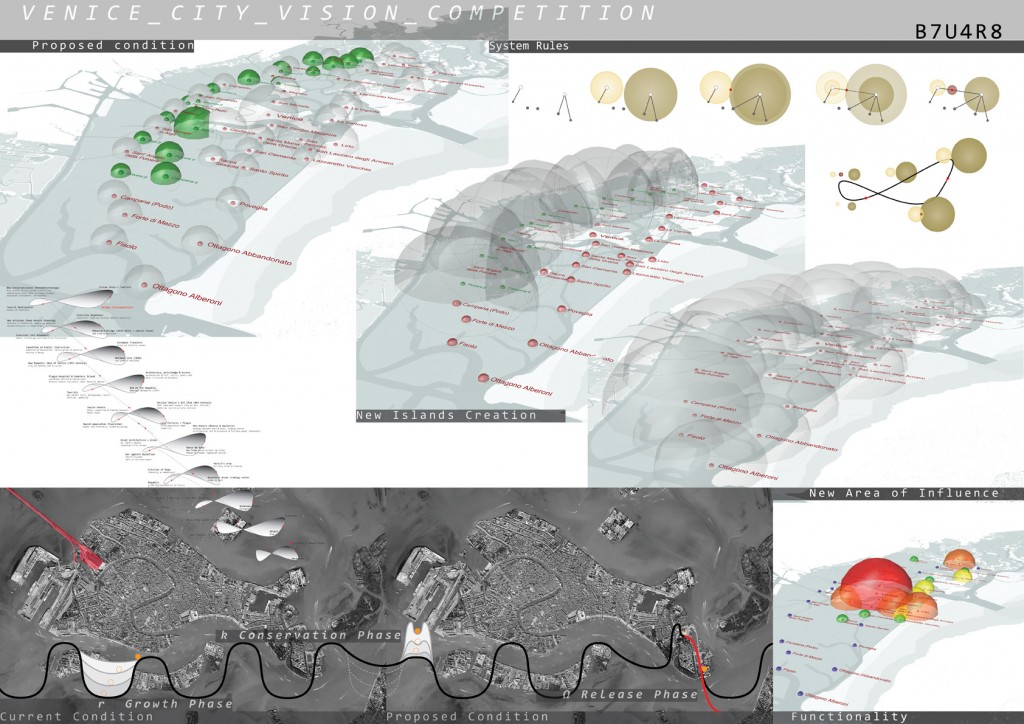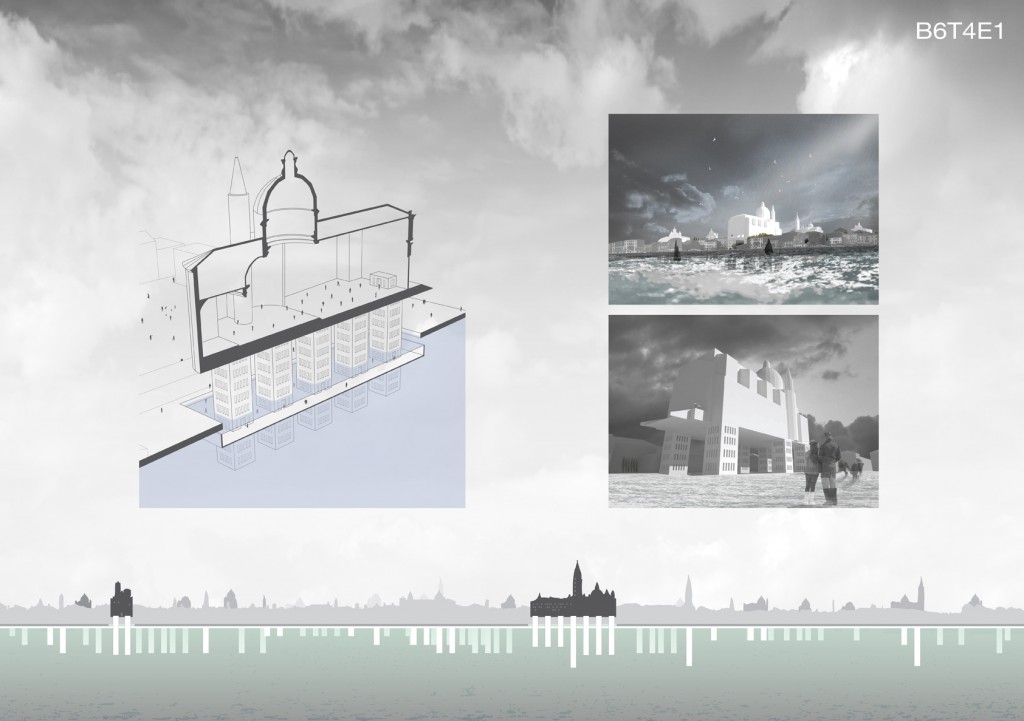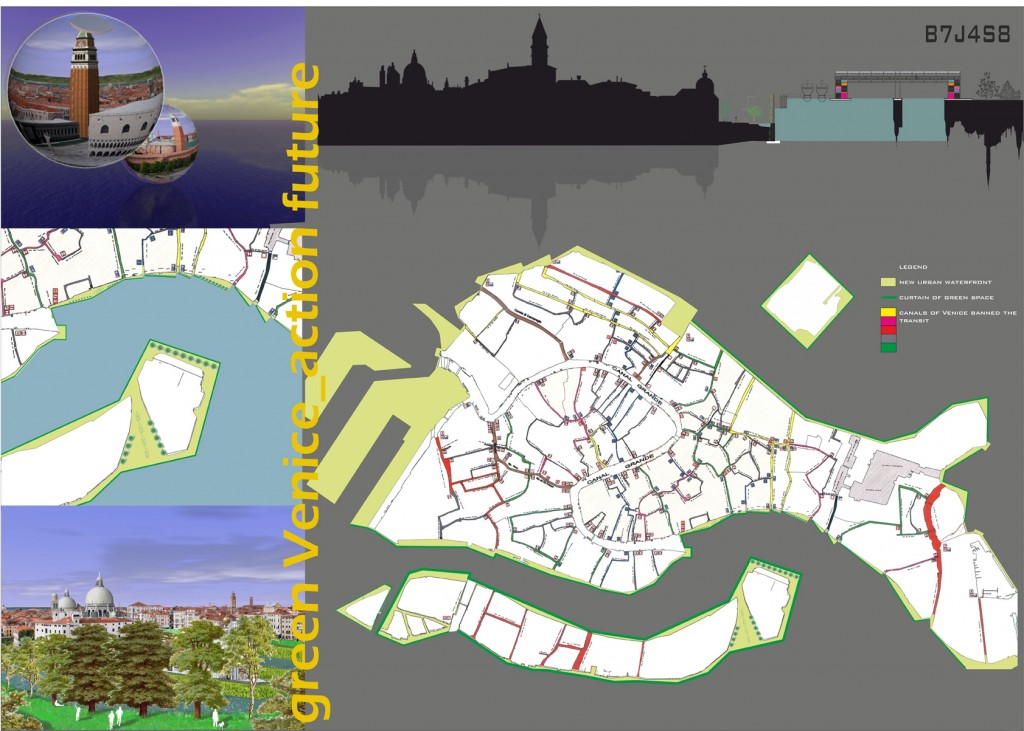Info:
Title: Green Venice action future - Code: B7J4S8Contest: Venice / 2011
By: G. Licari / A. Manfrè
Views: 2807 Likes: 0
Votes:
BJARKE INGELS4 NERI OXMAN3 ELENA MANFERDINI3 MARIA LUDOVICA TRAMONTIN5 BOSTJAN VUGA13.2
Green Venice action future
“[Venice] Thus arranged on both sides of the channel, the houses were to thinkof natural places, but of a nature that had created their works with a human image.”Marcel ProustYet if we cross the history of Venice with the 900 would find the last greatwork of urban Le Corbusier, not a Khan’s Palace Congress, a dream of reflection and the mosaic on the Gran Canal of Whright, but also the temporary utopias of Biennals Art and Architecture, Gugghenheim, Gran Canale paved by SuperStudio and Aldo Rossi’s Teatro del Mondo (a monumental that floats, such as subtle irony!), the sophisticated realism of the Valley with the ideology of urban Samonà, the architectural sheet metal and plastic with Gehry regionalism sophisticated Zucchi, fitness ideas and vision of IUAV with the acupuncture treatment of many internal Scarpa. Instead, today Venice is at risk ”extinction” means the complaint, the association “Venessia” that compares the risks they run the survival of this place with the collapse of the House of the Gladiators at Pompeii.
But why should it disappear? According to the association the uncontrolled tourism, the passage of cruise ships and in particular the possibility of moving the same market on the mainland are the ”evils” that kills it.
Venice has always played a key role in history, economics, politics and culture in European and Mediterranean during the centuries. It ‘been a hub for the city’s history, its lagoon and the seas that have formal relations with other cultures and civilizations from the beginning and have made his living space and the point of contact with Istria, Dalmatia, Albania, Greece and the Orient. But also for the history of the Veneto, Friuli and Lombardy, on which the late Middle Ages the city has gradually consolidated his rule and set up its ties with Italy and Europe. Nevertheless, the city will have a particular influence in the fifteenth to eighteenth centuries, during which the Republic of Venice reached the height of its fortunes in the Mediterranean cut out a vast territorial domain Po inland, becoming a star of events the Italian peninsula.
The progressive Turkish advance in the east and the expansion of French and Spanish monarchies in the West were soon because of its expansionist aims, but for a long time the republic continued to play a leading role in European politics, in the 700 before the changed the balance of power ultimately led to the crisis of the regime that the patrician palace. E ‘in this period, culture, art and historical reflection and Italian politics, European and Anglo-Saxon was born and consolidated the “myth of Venice” – it is positive or negative – that accompany the later history of the city and its image in the nineteenth and twentieth century. Around this phenomenon and its multiple readings and cultural and political uses and for at least these reasons, we will restore Venice to its millennial splendor, but conscious of being able to reproduce in an era in which certain approaches to urban planning by the government that followed and planning tools used in the last two decades have accentuated what was a substantial array of problems and their solutions for the proper use and livability of Venice, or marginalizing the relationship between urban systems design (for example , between the system infrastructure, the new centrality and settlement system or between it and the environmental system), and the lack of hierarchy in the treatment of the themes and issues to be addressed, given that emerging priorities, principles and values ??to pursue, and specificity of the city appeared homogenized within a generalist approach dominated by the rhetoric of “ee”.
In light of these problems, today it seems necessary to open a phase of project aimed mainly to outline a new global vision for the city, which seems to us more and more necessary for some simple reasons. Must therefore ask ourselves what role we entrust to Venice and its surrounding area as Mestre and Marghera, with the shift of the most valuable along the loop or around the airport. And what role we play within the broader “metropolitan area”, increasingly made up of toll highways, expressways, airports and loops, which could be considered “eccentric” our city.
The project is designed to Venice City Vision focuses on the need to develop technically feasible and make assumptions of growth and transformation based on the reuse of urban land is already developed, the “zero consumption” of agricultural land and the principle of invariance hydraulics. At the same time countering the idea of ??a city that is transformed only through the summation of separate events, a “tourist town hit and run” is unavoidable but bring attention to its overall roominess, comfort on daily life and quality of relationships between its parts, recognizing the “urban welfare” as the overall strategy.
These principles are taken to extremes can create new concepts of regional development and raising the environmental policy of urban green spaces which, if allowed to turn the city over the decades, providing it with parks, forests and bike paths, today can and must find a new momentum, positioning itself as a leading integrated policies, able to hold together the demands of environmental protection with those of the hydrogeological and safety of the construction of a new network of public spaces. [CREATION OF FORM] A project that aims to recapitalize the city and its surrounding area by providing them with a new plot of the commons, a new skin created by processes of physical-biological and ecological support and enabling the design of a field physics, a new curtain, protection of the historic city that is based on the principles of adaptability to environmental conditions.
[Meeting of civilizations '- CROSSING OF CIVILIZATION'] cultural-ecological armor – technology for the city at this stage of her life is almost entirely lacking, and this entails a re-integration of man at the center of debate future of the city, include actions and behaviors of a new urban culture and secondly programs that would transform the urban fabric bound and degraded in order to promote a more balanced distribution of services and infrastructure and to improve environmental quality and architectural urban space by eliminating the conditions of neglect and deterioration of buildings, environmental and social investing certain urban areas.
Info:
Title: Green Venice action future
Time: 7 giugno 2011
Category: Venice
Views: 2807 Likes: 0
Tags: Aldo Rossi , Architecture , Italy , Middle Ages , Social Sciences , Superstudio , Veneto , Venice








